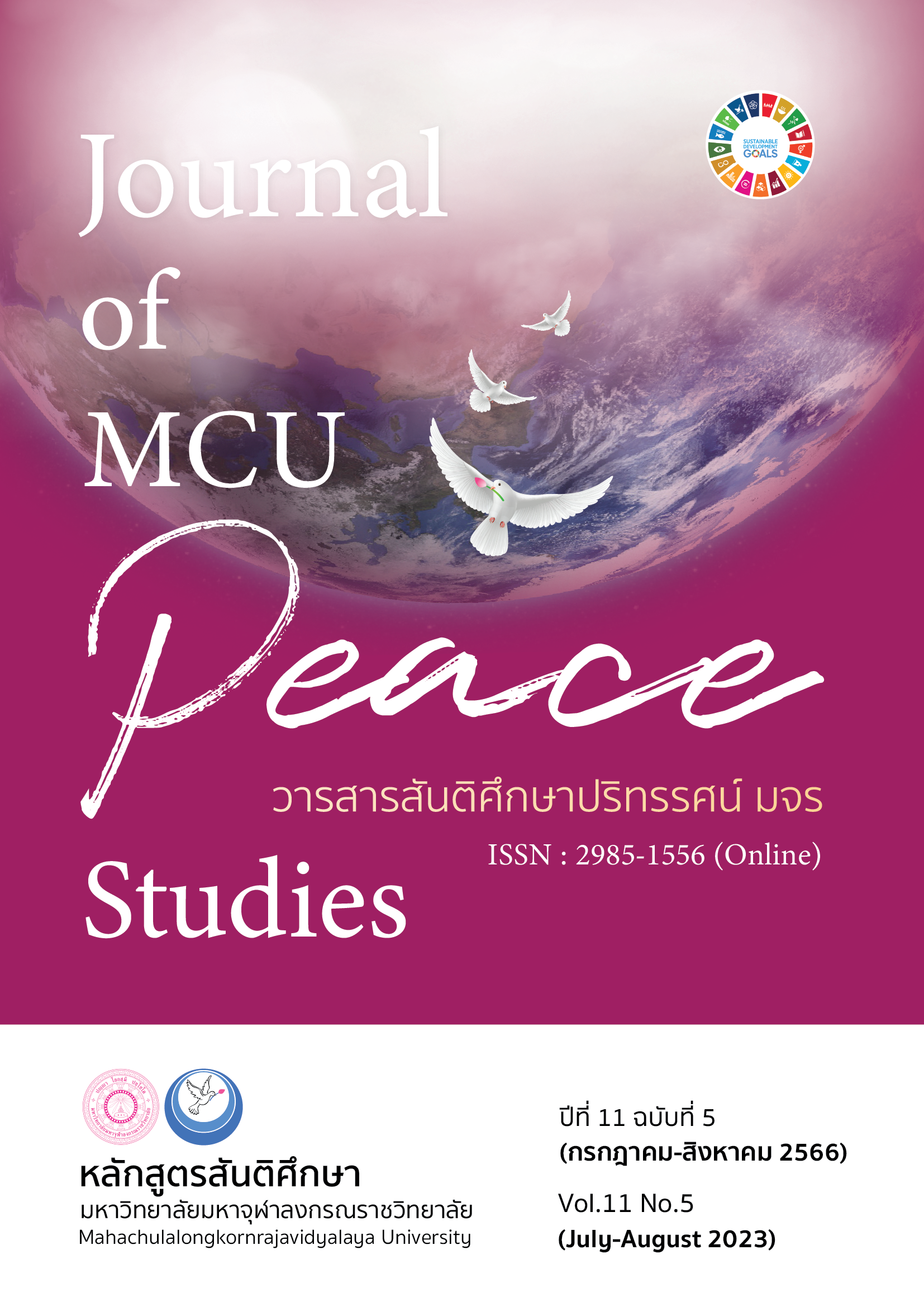การพัฒนาศักยภาพวิสาหกิจชุมชนสตรีโรงลาดเพื่อยกระดับเศรษฐกิจฐานราก โดยพุทธสันติวิธี
Main Article Content
บทคัดย่อ
บทความวิจัยนี้มีวัตถุประสงค์ 1) เพื่อศึกษาสภาพปัญหา และความต้องการจำเป็น และแนวคิดทฤษฎี หลักพุทธสันติวิธีที่เอื้อต่อการพัฒนาศักยภาพวิสาหกิจชุมชน 2) เพื่อนำเสนอการพัฒนาศักยภาพวิสาหกิจชุมชนสตรีโรงลาดเพื่อยกระดับเศรษฐกิจฐานรากโดยพุทธสันติวิธี ใช้รูปแบบการการวิจัยเชิงปฏิบัติการแบบมีส่วนร่วม เครื่องมือวิจัย คือ แบบสัมภาษณ์เชิงลึก และชุดปฏิบัติการพัฒนาศักยภาพวิสาหกิจชุมชนแบบมีส่วนร่วมอย่างเป็นระบบตามหลัก P-A-O-R ผู้ให้ข้อมูลสำคัญ จำนวน 15 คน และผู้ร่วมปฏิบัติการพัฒนาศักยภาพวิสาหกิจชุมชน จำนวน 15 คน วิเคราะห์ผลด้วยอุปนัยวิธี สรุปผลแบบพรรณนาโวหาร
ผลการวิจัยพบว่า 1) ปัญหาและจุดอ่อนที่ควรเสริมให้เกิดการพัฒนาศักยภาพวิสาหกิจชุมชนสตรีโรงลาด คือ การพัฒนาผลิตภัณฑ์เพื่อสร้างมูลค่าเพิ่ม การจัดสรรบทบาทหน้าที่อย่างเป็นระบบ การวิเคราะห์ต้นทุนสินค้าและการจัดการบัญชี แนวคิดทฤษฎีที่ใช้สำหรับการพัฒนาศักยภาพวิสาหกิจชุมชน ได้แก่ แนวคิดการมีส่วนร่วม การบริหารจัดการวิสาหกิจชุมชน เศรษฐกิจฐานรากตามปรัชญาเศรษฐกิจชุมชน หลักพุทธสันติวิธีที่เอื้อต่อการพัฒนาศักยภาพวิสาหกิจชุมชน ได้แก่ หลักอริยสัจ 4 ในการบริหารงานเพื่อแก้ปัญหาภายในกลุ่มแบบมีส่วนร่วม หลักอปริหานิยธรรม เพื่อเสริมสร้างความเข้มแข็งของกลุ่มวิสาหกิจชุมชน 2) การพัฒนาศักยภาพวิสาหกิจชุมชนสตรีโรงลาดเพื่อยกระดับเศรษฐกิจฐานรากโดยพุทธสันติวิธี ด้วยชุดปฏิบัติการแบบมีส่วนร่วมอย่างเป็นระบบ ตามวงจร P-A-O-R 9 รอบ แบ่งเป็น ระยะต้นน้ำ คือ การตรวจสอบปัญหาและวิเคราะห์สาเหตุ ระยะกลางน้ำ คือ การลงมือปฏิบัติตามแผนปฏิบัติการร่วมกัน ระยะปลายน้ำ คือ การนำแนวปฏิบัติที่พัฒนาร่วมกันมาปรับใช้และพัฒนายกระดับศักยภาพวิสาหกิจชุมชนด้วยความตื่นรู้และการเห็นเป้าหมายร่วมกัน พร้อมกับการทำงานร่วมกับเครือข่ายที่ส่งเสริมให้การสนับสนุนเพื่อการพัฒนาวิสาหกิจชุมชนอย่างยั่งยืน องค์ความรู้จากการวิจัย คือ “SAN MODEL”
Article Details

This work is licensed under a Creative Commons Attribution-NonCommercial-NoDerivatives 4.0 International License.
ทัศนะและความคิดเห็นที่ปรากฏในบทความในวารสาร ถือเป็นความรับผิดชอบของผู้เขียนบทความนั้น และไม่ถือเป็นทัศนะและความรับผิดชอบของกองบรรณาธิการ ยินยอมว่าบทความเป็นลิขสิทธิ์ของวารสาร
References
Kamplod, K., & Pongta, Th. (2022). Community Empowerment Analysis for Designing of Development Local Economy Innovation of Community in Pa Daet District, Chiang Rai Province. Journal of Social Academic, 15(1), 1-16.
Khatasombun, H. (2020). Foundations: Case Study of Noen Sala Subdistrict, Krok Phra District, Nakhon Sawan Province. Journal of MCU Peace Studies, 8(2), 474-488.
Kumpho. (2013). Concept and Background of Participatory Action Research. Retrieved May 17, 2022, from https://pongmed.wordpress.com/2013/08/26/par1/#more-82
Ministry of Agriculture and Cooperatives. (2015). Community Enterprise Promotion Act, B.E. 2548. Retrieved May 9, 2022, https://www.moac.go.th/law_agri-files-391991791824
Monaraks, V., Phramaha Hansa Dhammahaso, & Phra Promote Vatagovito. (2020). Sustainable Community Enterprise Development by Buddhist Peaceful Means: A Case Study of Sawai Community, Prang Ku District, Sisaket. Journal of MCU Peace Studies, 8(5), 1721-1735.
Office of the National Economic and Social Development Council. (2019). Master Plan under the National Strategy 16 Issues Grassroots Econymy (B.E. 2561-2580). Retrieved May 12, 2022, from http://nscr.nesdc.go.th/wp-content/uploads/2019/04/16-เศรษฐกิจฐานราก.pdf
P&M Research. (2011). Participatory Action Research: PAR. Retrieved May 30, 2021, from https://nakhonsawanresearch.blogspot.com/2011/10/participatory-action-research-par.html
Phakdeeying, R. (2020). The Potential Development for Community Enterprise Operation in Khonkaen Province. Journal of Buddhist Education and Research: JBER, 6(1), 175-189.
Phrakru Nitichanthachot Bunkhan. (2018). Participation of the People in Water Management for Agriculture according to the Brahma-Dharma Principle. The Journal of Research and Academics, 1(3), 99-110.
Phramaha Hansa Dhammahaso (Nithibunyakorn). (2004). A Pattern of Conflict Management by Buddhist Peaceful Means: A Critical Study of Mae Ta Chang Watershed Chiang Mai. (Doctoral Dissertation). Mahachulalongkornrajavidyalaya University. Bangkok.
Putdhimanee, K., Phramaha Hasa Chammahaso, & Watthanapradit, Kh. (2019). The Process of Buddhist Peaceful Means in Development of Participatory Areas and Communities by the Royal Thai Army. Journal of MCU Peace Studies, 7(supplement Issue), s224-s239.
Royal Gazette. (2019). Community Enterprise Promotion Act (No. 2) B.E. 2562. Retrieved December 5, 2022, from https://ratchakitcha.soc.go.th/documents/17076724.pdf
Somwatthanasak, D. (2005). Community Enterprises: Academic Documents. Chainat: Office of Agricultural Estension and Development Region 1, Chainat Province.
Tachateerapreda, S., Hongthai, S. & Preechana, Ch. (2017). The Participatory Action Research Project: Strategic Development for the Mobilization of Community Enterprise in Nakhon Ratchasima Province. Academic Journal of Humanities and Social Sciences Burapha University, 25(49), 215-245.
Trade Policy and Strategy Office. (2022). Report on the Potential Development of Community Enterprises/Social Enterprises to Raise the Grassroots Economy under the Trade and Service Potential Development Project to Raise the Grassroots Economy of Thailand. Retrieved July 9, 2022, from http://www.tpso.moc.go.th/th/node/11312

